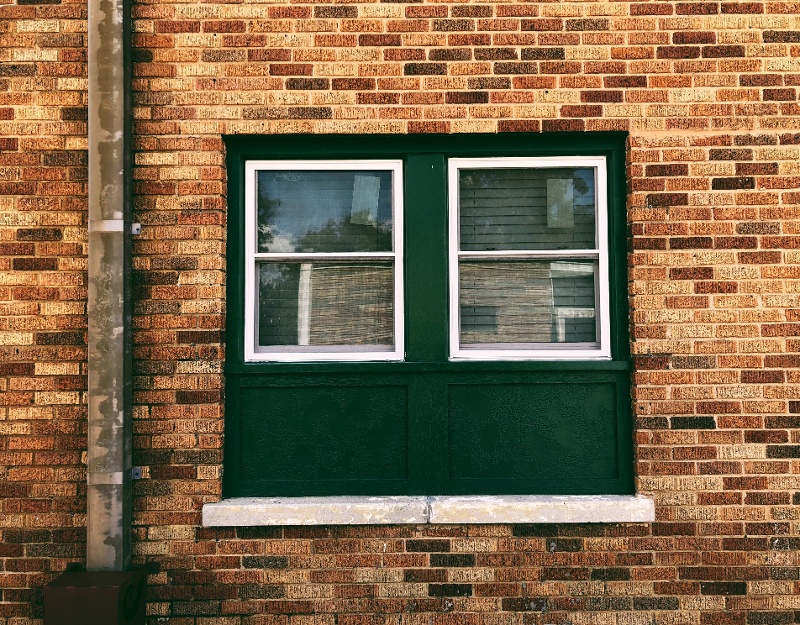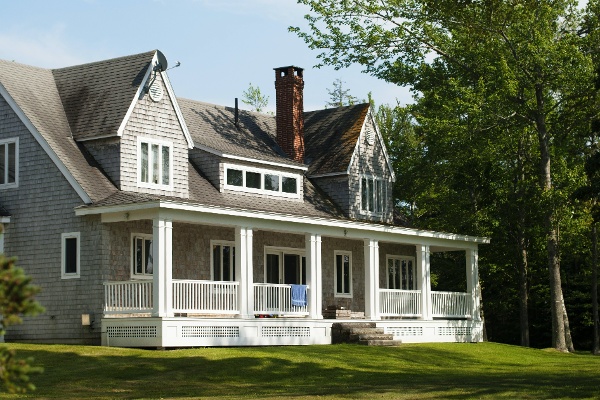The Complete Guide to Exterior Home Design
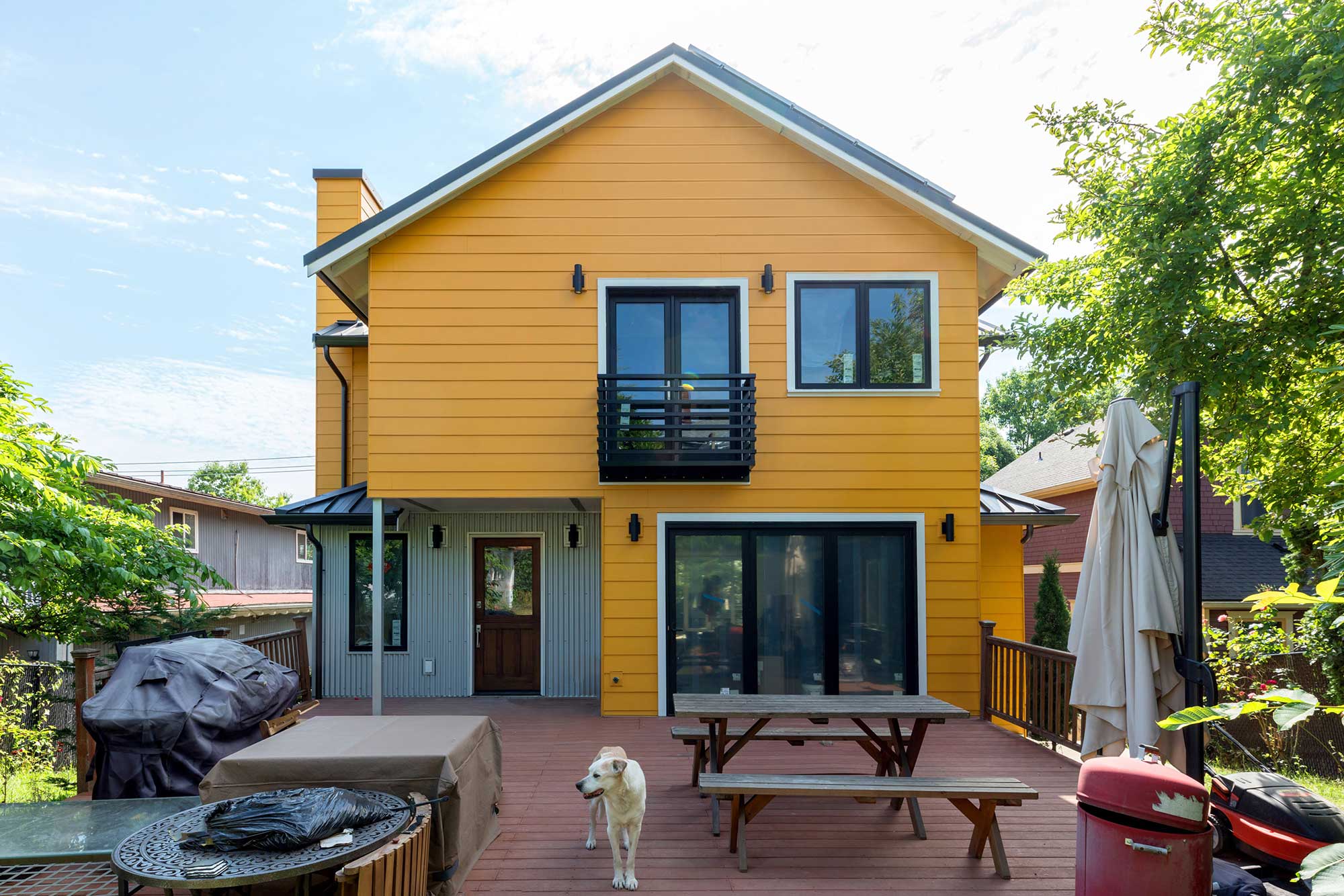
The exterior of your home should reflect you and the things you care about. That is most often accomplished through unique design (which also improves curb appeal). But it should equally have protection and longevity. And both of these considerations involve a common denominator — siding.
Fortunately, siding comes in a variety of colors and textures, budgets, styles, and forms. What is best for your house exterior depends on the look you want, your budget, and, in some situations, your location. Of course, a good contractor can help you decide what is best for your home and your situation. But it’s also useful to have your own solid understanding of what makes a brilliant exterior home design.
Siding Choices for Exterior Design
Whether you own a traditional or contemporary home, one of the first tasks when designing the exterior is deciding on what type of siding you will use for your project. There are a variety of options available, including the following:
Vinyl
Vinyl is one of the most commonly chosen materials for siding because it comes in a variety of textures and colors. It is also extremely durable, yet lightweight, and can often be installed over existing materials. It’s also quick to install, which saves on labor costs if you’re hiring a professional to help you.
Stucco
Water and cement, as well as lime and sand, combine to create stucco siding. Although some traditional synthetic stuccos have problems, quality stucco can be tinted to nearly any color and should be long-lasting. It offers a modestly elegant appearance and can have a pebble-like texture.
Stone Veneer
Limestone, granite, slate, and other stones are beautiful and long-lasting. Unfortunately, they are often costly. If you prefer the look of these materials, but don’t want to pay the price, stone veneer is an excellent alternative. Precast facings and stone veneers are often more affordable, and quality options appear quite genuine.
Fiber Cement
Depending on the application, fiber cement may look similar to masonry, wood, or stucco. It is often preferred by those who want a durable and natural-looking option. It boasts the benefits of being low maintenance, as well as fire- and termite-proof. However, because it is made of silica dust, it must be handled carefully.
Wood Clapboard
Although there are lots of other options, solid wood siding is still a fan favorite, especially as a design element. There’s something about the natural grain and feel of wood that adds a level of approachability, comfort and sophistication to a home’s exterior. And with routine maintenance, it can outlast all other kinds of siding. Depending on your color preferences, it also provides flexibility since it can be stained or painted.
Brick
Brick siding comes in a variety of colors, and although it is expensive, it can last for centuries. Brick veneer is also available and offers a cheaper alternative to traditional brick. However, it doesn’t tend to hold up as well as brick over time.
Cedar Shingle
Often called shake siding, cedar shingle is made of cedar (hence the name) and is typically stained brown, gray or other earthy colors. It offers the look of real wood but doesn’t require as much maintenance as wood clapboard.
Engineered Wood
This composite wood siding is made by mixing real wood with other materials. It often comes in panels that are inexpensive and easy to install. Because it has a uniform grain, it doesn’t look like real wood, but still appears more natural than vinyl or steel.
Steel
The most significant benefit to steel is the durability and low-maintenance reputation it has earned as a pre-finished material. It is often seamless and cut to the exact measurements of your home. For modern builds, steel is becoming a more popular choice as it creates a sleek and industrial look. It can also be purchased with a wood-look texture.
Pros and Cons for Different Home Exterior Siding Options
Now that you have a good idea of types of building products and siding options that are available for your exterior remodel or home design project, it is a good idea to consider the pros and cons of each type of siding.
Vinyl Siding
- Pros – This siding is lightweight, tough, and comes in a variety of textures and colors. It requires little to no maintenance, never needs repainting, and is relatively low in cost, especially compared to some other materials.
- Cons – There are usually visible seams and it looks cheap. It is also sensitive to heat and can easily warp or melt. If you need to make repairs to vinyl siding, it can be hard to match. It also is not very eco-friendly, as it is made of non-recyclable material and will last in a landfill for decades or even centuries.
Wood
- Pros – Wood siding is easy to cut and can be installed easily by a DIYer. It is naturally beautiful and prized by many designers and architects (especially because it can be used across many architectural styles). Plus, it can be sourced sustainably.
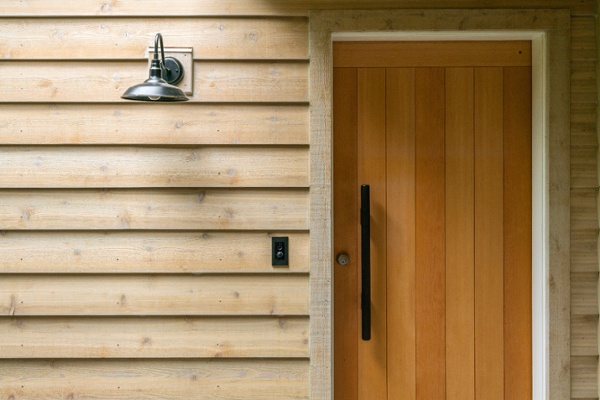
- Cons – It can be extremely pricey, and routine maintenance will add to the cost. Adding wood siding later will require removing any existing siding. A common annoyance is that pests like to feast on wood, which can add to the overall maintenance and repair cycle.
Fiber Cement
- Pros – This type of siding resists contractingand expanding in changing temperatures. It is also fire resistant and termite-proof and will not rot.
- Cons – It is heavy and requires specialized tools during installation. Adding this type of siding to your home typically requires a contractor experienced in this type of siding installation, and these contractors are not easy to find. Additionally, silica dust (which makes up fiber cement) is not good for you and requires proper protective equipment.
Stucco
- Pros – Beautiful, natural colors can be created with stucco, and the color goes all the way through the material, so painting will never be necessary. It is low maintenance and resistant to insects and fire.
- Cons – Meticulous prep work must be done before this siding can be applied, and finding an experienced stucco contractor can be difficult.
Engineered Wood
- Pros – This siding is easy to work with and is nearly impervious to insects. It often has a look similar to real wood siding without the cost of real wood siding.
- Cons – Some of the earlier versions of engineered wood siding experienced problems with moisture, and newer varieties haven’t been on the market long enough to know if there are further issues or if their longevity will hold up as claimed.
Stone
- Pros – The longevity of stone cannot be argued, nor the beauty. Synthetic stone or stone veneer provides the look of stone at a fraction of the cost. Stone is also fire and insect resistant.
- Cons – It is heavy and pricey and requires someone experienced in stone siding to install it. Stone veneer can have the look of real stone, but many say it still doesn’t look like the real thing. Even stone veneer and synthetic stone can be more expensive than other siding options.
Choosing a Color for Your Exterior Home Design
Picking a color for the exterior of your home is a big task. The color and overall design is the first thing you see when you look at a home. The decision you make on the color of your home will express the feel of your home for years to come.
With that said, keep in mind that the best colors are those that will highlight the beautiful features of your home, or mask a design flaw. The right colors will boost the market value of your home and increase your home’s curb appeal.
So, how do you find the perfect colors? Here are a few tips to get you started on coloring your exterior home design:
Consider History
If you are choosing colors for an older home, you might want to consider historically accurate colors. Refer to a historic color chart and choose colors from the same era as when your home was built. If your home has simple architecture, you will need fewer colors, but if your home is a Victorian-era home, for example, with ornate trim, you may need up to six colors.
Jazz Up the Past
Another option is to use modern paint colors to jazz up old architectural details. This can produce dramatic results. However, take into consideration what other homes in your neighborhood are doing. You don’t want to buy gallons of bright pink paint if you are located in a conservative neighborhood.
Consider Your Neighbors
Although you don’t want to stand out in stark contrast to your neighbors, you also don’t want to look exactly like your neighbor’s home or clash with nearby buildings. Choose your colors with an eye on what is around you, including the home styles. This may mean blending, contrasting or complementing the colors around you.
Look at Nature
The landscape around you is probably full of color ideas. A beach setting, for example, may scream of blues and turquoises, while a lot of trees may push you towards earthy browns and greens. Also take into consideration where the sun shines on your home and how it is positioned in the environment. Colors need light, and the way light hits your home will influence the color of your choice.
Check the Roof
Although the home is the canvas, it’s not an entirely blank canvas. Look at your roofing materials and colors. Your home exterior color doesn’t need to match your roof, but it should harmonize. 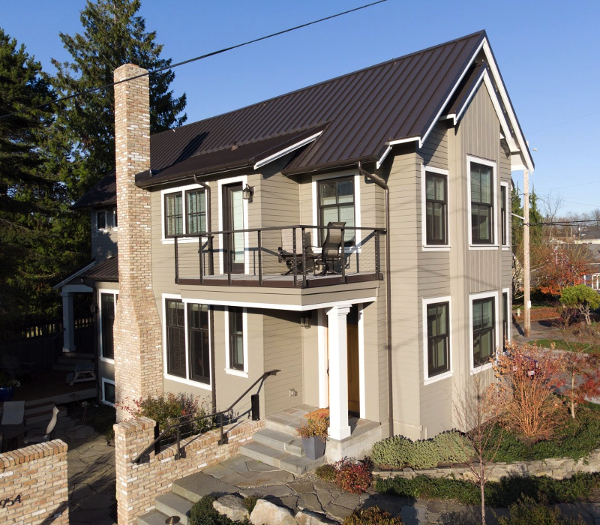
Accent the Details
If you have beautiful architectural details, consider making them a color that has an intentional relationship with the background color of the home. Use a contrasting or complementary color depending on what you are trying to achieve. Look at a photo gallery to help give you ideas for accent colors.
Average Cost to Reside a House
When it comes to siding a new home or residing an existing home, it can be difficult to know in advance what you should expect to spend. So an average cost breakdown of siding material can help quite a bit in the decision and planning phase.
Generally, you can plan on spending between $5,378 to $15,477. High-end installations can exceed $30,000. If it’s necessary to remove old siding from your home to reside it, you can plan on an additional $1,000 to $3,000 for that as well. Labor costs make up roughly 25 to 50 percent of the cost of siding your home, and that will be figured into the cost as well.
The full cost of your residing project will depend on the type of siding you choose for your home. Here is a breakdown of what you can expect based on siding type:
Vinyl
This type of siding will average $2 to $7 per square foot.
Wood
This siding offers a lot of character but is a bit more costly at $3 to $15 per square foot.
Engineered Wood
Engineered wood siding will be similar in cost to vinyl siding at $1.50 to $7 per square foot.
Steel
Depending on whether you choose aluminum or steel siding, you can expect to pay $3 to $8 per square foot.
Fiber Cement
This siding is also similar in cost to vinyl siding with an average price of $2 to $6 per square foot.
Brick and Brick Veneer
Of course, veneer is going to be cheaper than brick, but you can anticipate paying $12 to $18 per square foot for brick siding and $11 to $15 per square foot for brick veneer.
Stone
Stone is the most expensive type of siding. You can expect to pay an average of $10 to $18 per square foot for stone veneer and $15 to $30 per square foot for stone.
Home Exterior Design Ideas and Inspiration
Although it’s been said that you shouldn’t judge a book by its cover, that is often precisely what happens, especially when it comes to a home. The exterior of your traditional or modern home gives first impressions of what’s inside the doors, or be in stark contrast.
But often, people don’t know where to start. That’s where completed projects can offer inspiration and stir up creative ideas for your own design. Here are a few exterior design ideas to get you started.
Add a Fresh Coat of Paint
Rejuvenate your home with a new paint selection, even if it is just changing the color of the shutters and front door.
Showcase Your Entry
Add new garden beds around the entrance, lay down a new welcome mat, or change the color of your front door.
Expand a Deck or Porch
Adding more outdoor space can create a haven for relaxation and entertainment.
Play With Door and Window Trim Colors
Although these things may seem insignificant to the rest of your home, they are the perfect place to add contrast. You can always use traditional black or white, but consider non-traditional colors like oranges, reds, blues and yellows.
Add Shutters
Just like changing up trim, adding shutters can make a huge impact. They are also the perfect way to add color without making a drastic change in the color scheme.
Remodel the Landscape
Exterior home design goes beyond the home. Consider having a professional landscaper give you their opinion or give a landscaping design tool a try. If that’s not in the budget, a well-manicured lawn, trimmed shrubs, and tidy driveway go a long way in giving your property curb appeal and value.
Cleaning and Maintaining Your Home Exterior
The outside of your home is exposed to the elements year-round, so it only makes sense that they would get dirty too. Just like a clean interior feels good to come home to, a fresh home exterior will feel equally as welcoming. Not sure exactly how to go about cleaning the outside of your home? Here are a few tips to get you started:
Repair and Clean the Deck
If it has loose boards, decay or cracks, it may need a bit more work. But at least pressure wash the deck to clean it off. Then consider applying a waterproof coating after it is cleaned and dried.
Clean Gutters and Window Wells
Leaves, seeds and other lawn debris can accumulate in your window wells and gutters. Clear this debris so rainwater will drain away from your home’s foundation.
Inspect Your Roof
If you aren’t comfortable climbing on your roof, use binoculars to check the condition of your roof (or hire a professional). It is a vital part of your home that needs regular maintenance.
Caulk Cracks
Look for gaps around doors and windows and reapply caulk to stop leaks.
Repair Your Driveway
If you see a crack or hole in your driveway, it can be a growing problem. Patch or fill cracks with a concrete repair product. Asphalt is harder to work with, so you may need to contact a professional.
Maintain Siding
Depending on the kind of siding you have, it will likely need different types of care. However, you should at least check for areas that have cracks and need to be repaired. Some siding, like vinyl, can benefit from a power wash each year. Other siding, such as wood, should be treated every four years to protect it from the elements.
How We Can Help
At Synapse Construction, we know you want a first-class home exterior that’s built to last. That’s why we’ve dedicated years to crafting beautiful designs that are made to endure the elements of the Pacific Northwest.
So if you want craftsmanship and design that gives your home the look and feel you’ve always wanted, and the peace of mind that it’s built to last, talk to us. Our award-winning experience can help you revitalize your curb appeal with an exterior home design you’ll love.

